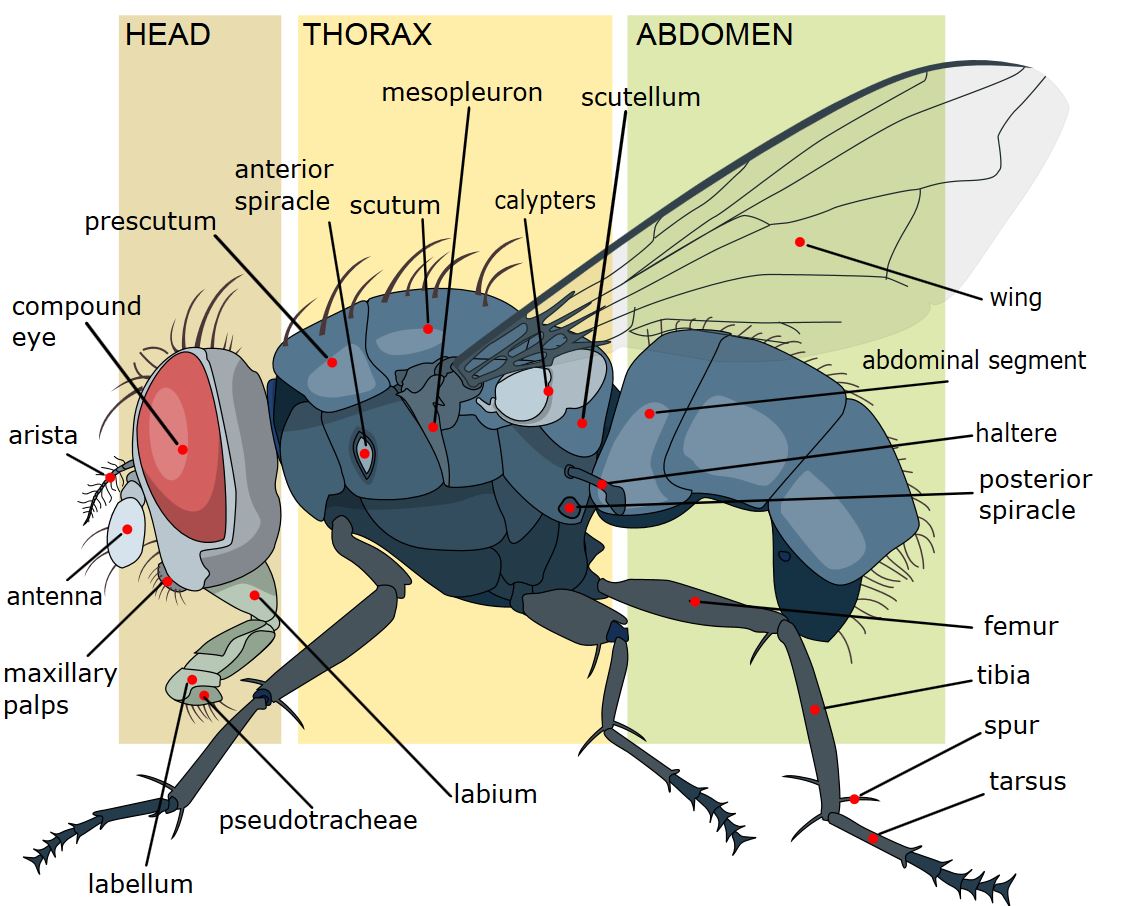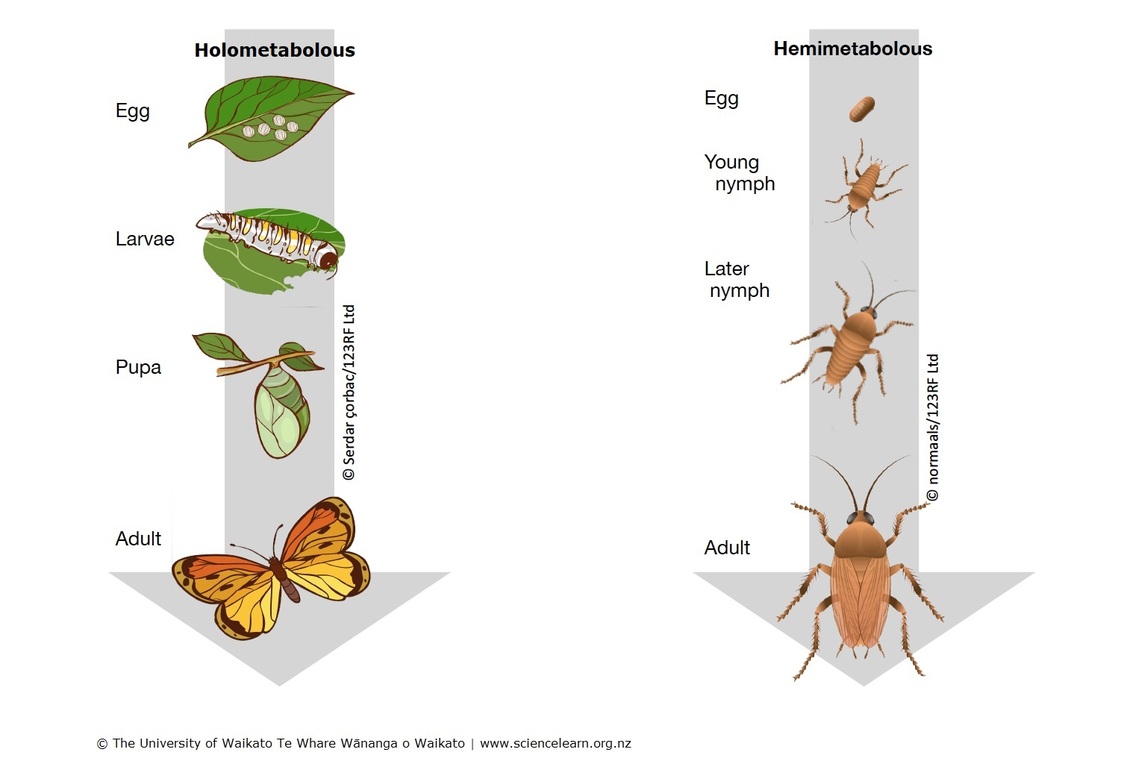Insects Study Guide
Introduction:
- The word “insect” means having a divided body or “insectum” in Latin. The study of insects is called Entomology.
- Insects are a group of winged arthropods with a head, abdomen, thorax, six jointed legs, and antennae.
- They are the widest animals, having more than one million different species.
- Some common examples are butterflies, cockroaches, flies, ladybugs, etc.
Morphology of Insects
-
The exoskeleton or the hard outer covering of insects is typically chitin.
-
The body is segmented into three interconnected parts: the head, thorax, and abdomen.
-
There is a pair of sensory antennae on the top of the head and a pair of compound eyes. “Ocelli” or simple eyes are also present in the head region.
-
The thorax consists of the prothorax, metathorax, and mesothorax, each having a pair of legs and a pair of legs on the meso and metathorax.
-
The abdomen comprises eleven segments, digestive, excretory, reproductive, and respiratory structures.
-
The nervous system consists of the ventral nerve cord and the brain.
-
The reproductive organs are accessory glands, two ovaries, 2 testes, and one or two spermatheca.
-
Respiration in insects occurs through openings on the abdomen sides and thorax sides called “spiracles.”
-
The gas is diffused throughout the body through a system of sacs and tubes called the “trachea.”
Metamorphosis in Insects
This is a physiological development process in all insects and may be either complete or incomplete metamorphosis.
-
Insects who change with incomplete metamorphosis are called Hemimetabolous insects, and they gradually outgrow their exoskeleton by a process known as “molting.”Here a new epicuticle is secreted within the outer epidermis, and the outer cuticle gets detached, as seen in the case of nymphs, damselflies, and dragonflies.
-
Holometabolous insects undergo complete metamorphosis and undergo four stages, namely, the egg stage, larval stage, pupal stage, and the final adult. A good example of this is seen in butterflies.
Types of Insects
There are thirty orders of known insects. Some are listed as follows:Archaeognatha: they do not have wings, and an example is Petrobius maritimus.
- Coleoptera: which includes beetles, bugs, ladybugs, etc.
- Diptera: include flies and mosquitoes.
- Dermaptera: includes earwigs.
- Ephemeroptera: includes mayflies.
- Hemiptera: includes giant water bugs.
- Blattodea: includes the termites.
- Hymenoptera: includes bumblebees, wasps, bees, and ants
- Lepidoptera: includes butterflies and moths
- Mantodea: includes the Mantids.
- Mecoptera: includes scorpionflies.
- Neuroptera: includes lacewings.
- Odonata: includes dragonflies.
- Phasmatodea: includes stick insects
Relationship to Humans
There are many beneficial roles of insects.
-
Bees, wasps, butterflies, ants pollinate the plants in the flowering stages as they feed on flower nectar.
-
In this way, they spread the pollen from one plant to another and help in cross-pollinating.
-
This is important in agriculture since it helps in the propagation of plants.
-
They also assist in producing substances like honey, silk, wax, and lacquer.
-
Insects that feed on other insects are important in pest control and aid in their control in agriculture.
-
In medicine, insects like the fly larvae are used to stop gangrene since they feed on flesh. Insects are also used in biological scientific research.
-
They are also consumed as food in some parts of the world.
-
In farming, insects are used as feed material for farm animals like pigs, fish, and chickens.
-
They are also used to prepare insect butter, insect cooking oil, grease, chitin, etc., and are used in the pharmaceutical industry.
Locomotion
- Insects are the only type of invertebrates to move about by the feature of flight.
- To walk, insects use the tripedal gait with their six legs, allowing them to walk faster.
- Some quick runners are cockroaches who use the bipedal run movement.
- Water striders can walk on water surfaces.
Vision and production of Light
- Members of insect families such as Lampyridae, Staphylinidae, Elateridae, etc., have the bioluminescence property as they produce light and glow.
- Fireflies and beetles of the Lampyridae family are classic examples.
- They use the glowing ability to attract mates and lure prey.
- Dull blue, green, and rare red are glowing insect colors.
- Some insects can detect infrared, ultraviolet, visible light, and even different colors.
Production of Sounds
- Insect science reveals that they are well known for producing and detecting sounds.
- They use their appendages to make sounds like the grasshoppers and crickets stridulate.
- The cicadas create the loudest sounds that modify their bodies to amplify the produced noise.
- Some insects can detect ultrasounds and avoid their predators like the hawk moth.
- Production of ultrasounds is seen in some insects.
Conclusion:
The social behavior of insects like bees, termites, ants, etc., prove that they can live and prosper in well-integrated colonies, making them superorganisms.
FAQs:
1. What are five examples of insects?
Insects are an antennae-bearing group of winged animals, including spiders, ants, flies, cockroaches, etc.
2. What do you mean by insects?
Insects are common pancrustacean invertebrates like houseflies, bedbugs, ants, which belong to the class Insecta of phylum Arthropoda.
3. What are the five characteristics of insects?
Insects have a hard exoskeleton and three main body parts: the head, abdomen, and thorax, two antennae on the head, six legs, and four wings.
4. Is a lizard an insect?
No, the lizard is not an insect. It is a reptile.
5. What is another word for insects?
Arthropod is another word for insects.
We hope you enjoyed studying this lesson and learned something cool about Insects! Join our Discord community to get any questions you may have answered and to engage with other students just like you! Don’t forget to download our App and check out our awesome VR room for this guide – we promise, it makes studying much more fun!😎
Sources:
- Insects https://flexbooks.ck12.org/cbook/ck-12-biology-flexbook-2.0/section/11.11/primary/lesson/insects-bio/ Accessed on 3 Dec 2021.
- Insect https://www.britannica.com/animal/insect Accessed on 3 Dec 2021.
- Insects – physical characteristics. https://www.sciencelearn.org.nz/resources/2842-insects-physical-characteristics Accessed on 3 Dec 2021.
- INSECTS, THEIR CHARACTERISTICS, MANTIDS, WATER INSECTS, CICADAS, AND KATYDIDS. https://factsanddetails.com/world/cat52/sub333/item1597.html Accessed on 3 Dec 2021.


